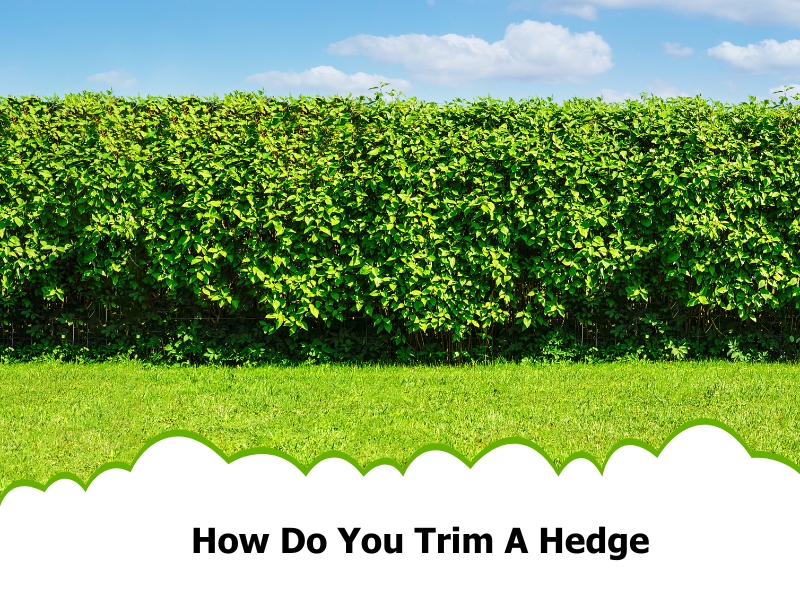Trimming a hedge is a vital gardening task that keeps your outdoor space tidy and well-maintained. Proper hedge trimming is essential, whether you’re aiming for a neat boundary, a decorative shape, or simply to encourage healthy growth. This guide will explain how to trim a hedge, from the best tools to the right timing and techniques.
Why should you trim your hedge?
Regular hedge trimming is more than just an aesthetic choice. Here’s why it’s crucial:
- Promotes healthy growth: Trimming encourages new growth and keeps the hedge dense and lush.
- Prevents overgrowth: Regular cutting prevents the hedge from becoming overgrown and unmanageable.
- Enhances appearance: A well-trimmed hedge adds to the visual appeal of your garden or property.
- Improves safety: Keeps the hedge from obstructing pathways or causing visibility issues.
What tools do you need to trim a hedge?

Having the right tools can make hedge trimming much easier and more effective. Here’s what you’ll need:
- Hedge shears: Ideal for shaping and trimming smaller hedges. Choose high-quality, sharp shears for a clean cut.
- Loppers: Useful for cutting thicker branches that shears can’t handle. They offer more leverage and cutting power.
- Hedge trimmers: Electric or gas-powered trimmers are great for larger hedges. They speed up the process and reduce manual effort.
- Gloves: Protect your hands from thorns, sharp branches, and blisters.
- Safety glasses: Shield your eyes from debris and falling branches.
When is the best time to trim a hedge?
Timing is crucial for successful hedge trimming. Trimming at the right time ensures that your hedge remains healthy, recovers quickly, and thrives. Here’s when to do it:
- Late winter to early spring: This is often the best time for most hedges. During this time, hedges are still dormant and aren’t actively growing. Trimming them now helps the hedge recover quickly once the growing season begins. This timing also allows you to shape the hedge before new growth starts, making it easier to manage and shape.
- After flowering: Timing your trimming after flowering hedges have finished blooming is essential. This approach prevents you from cutting off the next season’s flowers. Each type of flowering hedge has its specific blooming period, so it’s vital to know your hedge’s flowering schedule. Trimming after flowering ensures the hedge has ample time to develop buds for the next bloom.
- Avoid trimming in extreme weather: It’s essential to avoid trimming during very hot, cold, or wet conditions. Extreme heat can cause stress to the hedge and lead to sunburn on freshly cut branches. Cold weather, particularly freezing temperatures, can damage newly cut branches, making the hedge vulnerable to frost damage. Wet conditions can increase the risk of spreading diseases and cause the branches to become heavy and difficult to trim appropriately. Choose mild, dry days for trimming to minimise stress and damage to the hedge.
How do you prepare your hedge for trimming?
Proper preparation can make the trimming process smoother. Follow these steps:
- Inspect the hedge: Check for any signs of disease or pests. Treat these issues before trimming.
- Clear the area: Remove debris or obstacles around the hedge to make trimming more accessible and safer.
- Plan your cut: Decide on the shape and extent of the trimming. Sketch out a plan, if necessary, to visualise the final look.
Step-by-step hedge trimming
Here’s a simple, step-by-step guide to trimming your hedge:
- Start with the sides: Begin by trimming the sides of the hedge. Work from the bottom up to maintain an even shape.
- Shape the top: After the sides are done, move on to the top. Aim for a slight taper towards the top to ensure sunlight reaches all parts of the hedge.
- Trim for density: For a denser hedge, trim slightly more aggressively. This encourages new growth and a fuller appearance.
- Check for evenness: Step back regularly to check if the hedge is even. Make adjustments as needed to correct any uneven areas.
How often should you trim a hedge?
The trimming frequency depends on the type of hedge and its growth rate. Regular trimming helps maintain the desired shape and encourages healthy growth. Generally:
- Fast-growing hedges, like privet or leylandii, may need trimming 2-3 times yearly to keep them in shape. If not regularly maintained, they can quickly become unruly.
- Once a year, slow-growing hedges may be sufficient. Slow-growing varieties, such as yew or boxwood, tend to hold their shape longer, reducing the need for frequent trimming.
- Formal hedges require more frequent trimming to maintain their shape and appearance. They are often used for decorative purposes and need precise and regular cuts to preserve their structured look.
How do you trim a hedge in different shapes?

Different hedges require different approaches:
- Square or rectangular hedges: Use a level and string line to guide your cuts for a straight edge. Ensure even trimming on both sides.
- Round or oval hedges: Maintain a consistent shape by frequently stepping back and checking the symmetry.
- Topiary hedges: Requires a more precise approach and templates or guides for complex shapes.
How do you care for your hedge after trimming?
Post-trim care helps ensure your hedge stays healthy and vibrant:
- Water the hedge: Give your hedge a good watering to help it recover from the trimming process.
- Apply fertiliser: Use a balanced fertiliser to promote new growth.
- Monitor for pests: Check for pests or diseases and treat them promptly if they appear.
Final thoughts
Trimming your hedge doesn’t have to be a daunting task. With the right tools, timing, and techniques, you can maintain a beautiful and healthy hedge that enhances your garden’s look and feel. Regular care and proper trimming ensure your hedge remains a standout feature in your outdoor space.
Ready for a professional touch?
If you prefer to leave hedge trimming to the experts, A Bargain Gardener offers professional hedge trimming services. Our experienced team can help you achieve the perfect shape and maintain your hedge. Contact A Bargain Gardener today for a consultation and give your hedge the attention it deserves!


